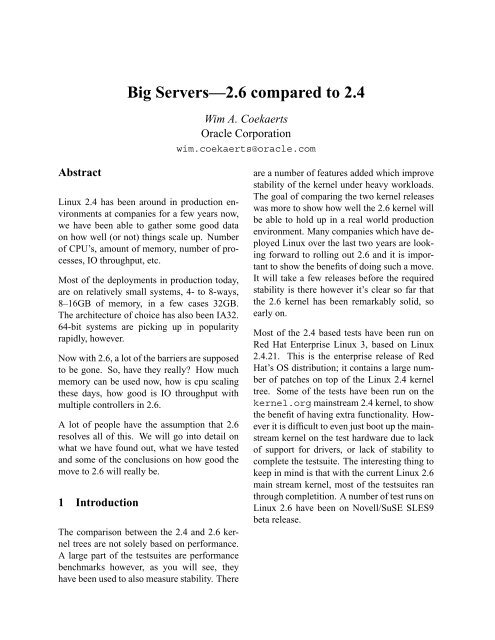You also want an ePaper? Increase the reach of your titles
YUMPU automatically turns print PDFs into web optimized ePapers that Google loves.
Big Servers—2.6 compared to 2.4<br />
Wim A. Coekaerts<br />
Oracle Corporation<br />
wim.coekaerts@oracle.com<br />
Abstract<br />
<strong>Linux</strong> 2.4 has been around in production environments<br />
at companies for a few years now,<br />
we have been able to gather some good data<br />
on how well (or not) things scale up. Number<br />
of CPU’s, amount of memory, number of processes,<br />
IO throughput, etc.<br />
Most of the deployments in production today,<br />
are on relatively small systems, 4- to 8-ways,<br />
8–16GB of memory, in a few cases 32GB.<br />
<strong>The</strong> architecture of choice has also been IA32.<br />
64-bit systems are picking up in popularity<br />
rapidly, however.<br />
Now with 2.6, a lot of the barriers are supposed<br />
to be gone. So, have they really? How much<br />
memory can be used now, how is cpu scaling<br />
these days, how good is IO throughput with<br />
multiple controllers in 2.6.<br />
A lot of people have the assumption that 2.6<br />
resolves all of this. We will go into detail on<br />
what we have found out, what we have tested<br />
and some of the conclusions on how good the<br />
move to 2.6 will really be.<br />
1 Introduction<br />
<strong>The</strong> comparison between the 2.4 and 2.6 kernel<br />
trees are not solely based on performance.<br />
A large part of the testsuites are performance<br />
benchmarks however, as you will see, they<br />
have been used to also measure stability. <strong>The</strong>re<br />
are a number of features added which improve<br />
stability of the kernel under heavy workloads.<br />
<strong>The</strong> goal of comparing the two kernel releases<br />
was more to show how well the 2.6 kernel will<br />
be able to hold up in a real world production<br />
environment. Many companies which have deployed<br />
<strong>Linux</strong> over the last two years are looking<br />
forward to rolling out 2.6 and it is important<br />
to show the benefits of doing such a move.<br />
It will take a few releases before the required<br />
stability is there however it’s clear so far that<br />
the 2.6 kernel has been remarkably solid, so<br />
early on.<br />
Most of the 2.4 based tests have been run on<br />
Red Hat Enterprise <strong>Linux</strong> 3, based on <strong>Linux</strong><br />
2.4.21. This is the enterprise release of Red<br />
Hat’s OS distribution; it contains a large number<br />
of patches on top of the <strong>Linux</strong> 2.4 kernel<br />
tree. Some of the tests have been run on the<br />
kernel.org mainstream 2.4 kernel, to show<br />
the benefit of having extra functionality. However<br />
it is difficult to even just boot up the mainstream<br />
kernel on the test hardware due to lack<br />
of support for drivers, or lack of stability to<br />
complete the testsuite. <strong>The</strong> interesting thing to<br />
keep in mind is that with the current <strong>Linux</strong> 2.6<br />
main stream kernel, most of the testsuites ran<br />
through completition. A number of test runs on<br />
<strong>Linux</strong> 2.6 have been on Novell/SuSE SLES9<br />
beta release.

















